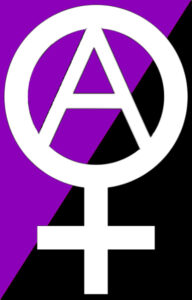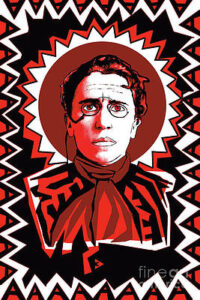Main Body
Anarchist (Anarcha) Feminism
James Donahue, Eva Kohn, Itzel Medina

Anarchist (also known as Anarcha) Feminism is a theory that female subordination is determined as much by a system of sexual and familial relationships as by state controls, and that legal change cannot in itself provide equality without full psychological independence (Humm 2003, 8). Anarchist feminism would eliminate all social restraints and replace these with decentralized, organic communities of women (Humm 2003, 8). The theory of anarchy is the idea that people are inherently good and capitalistic governments prevent true equality (New York Historical Society 0:37-45), and also a disbelief in any form of government due to its unnecessary and undesirable nature.
Early feminist anarchists (for example, Emma Goldman and Voltairine de Cleyre) believed that social attitudes would grow organically into sexual and psychological freedom (Humm 2003, 8). Second wave feminism, which began in the 1960s, was founded upon anarchist practice as a way to fundamentally challenge women’s roles in society by deeply analyzing the systems and institutions that were holding them back (An Anarchist FAQ 2023, 0:13-19). The anarcha-feminism term came as a result of anarchists working within the feminist movement, reminding individuals of the principles laid out (An Anarchist FAQ 2023, 0:20-27). The biggest critique of the second wave is its inability to take intersectionality into account, how black and trans or even black-trans women are affected differently than their white counterparts. This would be considered anarchist principle and a reason why the third wave was instituted to get down to the surface of issues affecting ALL women.
Anarchist feminism focuses on a need to act as soon as possible. A significant part of the emphasis on action is for everyone to act as one and have no separation of leaders or any one person possessing more power than others. Anarcha feminists also believe in resources for women to be provided by women or run by women, such as crisis centers, discussions, or studies of feminism. Anarchist feminism aims to eliminate systems that cause oppression such as capitalism and some forms of government rather than other forms of feminism that aim to put women in positions of power within those systems. Some of the systems that anarchist feminism dictates need abolition are patriarchy, marriage, capitalism, the state, and organized religion (which most anarcha feminists agreed).
Anarchist feminism believes in the existence of five main forms of oppression of women: ideological, state, economic, violent, and oppression derived from lack of organization.
- Ideological oppression comes from brainwashing by some cultural traditions or religions as well as propaganda and advertising. Ideological oppression is also a form of manipulation that preys on women’s feelings and vulnerabilities.
- State oppression comes from hierarchy in society and how it infiltrates interpersonal relationships and “private life.”
- Economic oppression refers to exploitation of both consumers and workers in both the home and outside the home.
- Violent oppression occurs mostly in private sectors. It can occur both as abject physical violence and as coercion.
- The oppression that comes from lack of organization is the absence of responsibility which fosters inactivity and weakness. (“Anarchafeminist Manifesto”).
These several types of oppression can not work alone and thus work simultaneously, creating a cycle that seems unbreakable (“Anarchafeminist Manifesto”). Again, it can be seen that the main focus of anarcha feminism is the immediacy of action. Breaking this cycle involves changing ideologies and plans of action today, right now, and not tomorrow or in the future. The future must be perceived in the present, which makes anarchist feminism seem difficult or daunting to outside viewers because a lot of problems do not have immediate solutions (or so it may seem).
The Most Dangerous Woman in America

Emma Goldman was born in 1869 in Lithuania until her family later moved to Russia where she worked in a factory and became irate at the conditions of the labor industry and capitalism. She was incredibly inspired as a teenager by the Russian revolutionary movement, which imagined a society of free equals, a tantalizing Utopia in which all problems could be solved on earth, by ordinary people without the Czarist regime (PBS). Goldman would move again but this time across continents, landing in Rochester, New York and later New York City where she would witness firsthand atrocious working conditions like long hours, unequal pay, and poor safety conditions as a factory worker and nurse (The Library of Congress). She had a prominent role in the shaping of 20th century anarchist ideals and its subsequent fusion with feminism, so much so that the FBI later labeled her “The Most Dangerous Woman in America” (New York Historical Society 2022).
Emma Goldman developed a reputation as a prolific speaker, garnering the attention of her audience while calling for a revolution by any means necessary. Amongst her beliefs were freedom of speech, birth control/contraception, and the eight-hour work day implemented today in a plethora of professions. One of her speeches was so influential to fellow anarchist, Leon Czolgosz, that he assassinated the 25th President of the United States, William McKinley, in 1901 (PBS). Although she opposed violence in theory, Goldman defended it in practice by shifting the blame for acts of violence onto the state and governing classes (PBS). Prior to this assassination, Goldman (although not found guilty) was thought to have aided her partner, Alexander Berkman, in the attempted assassination of the corrupt Henry Clay Frick for his atrocious treatment of workers (New York Historical Society).
Quickly, she garnered national attention for her speeches which were known for reaching a varied audience by Americanizing anarchism (PBS). Goldman published Mother Earth (1906-17), a monthly anarchist newspaper that would later be banned by the U.S. for its taboo topics like women’s rights (PBS). In fact, she also took aim at the Suffrage movement, claiming that they should focus on the entire system as the problem, not voting rights (New York Historical Society). Amongst her most radical views was her views on monogamy, being dubbed the “mother of non-monogamy” (New York Historical Society) and expressed her discontent with marriage in “Marriage and Love” (1914).
After spending two years in prison for encouraging people to dodge the World War I draft, Goldman was deported to Russia amidst tyranny and corruption in 1919 (PBS). Yet, she would not stop here, leaving Russia two years later and traveling across Europe speaking about anarchism and spreading her message wider. Unfortunately, she was never allowed back to the United States and died in 1940 from a stroke. Nevertheless, she cemented herself as a relentless figure who would stop at nothing to inspire and react to oppression no matter the circumstances.
Works Cited
“Anarchafeminist Manifesto.” The Anarchist Library, https://theanarchistlibrary.org/library/anonymous-anarchafeminist-manifesto. Accessed 30 October 2023.
An Anarchist FAQ. “What is Anarcha-Feminism? | A.3.5 | An Anarchist FAQ Audiobook.” YouTube video. February 16, 2023. https://youtu.be/mKYJCWHSTRw?si=yF_dRMQFwY4sf_wW.
“Emma Goldman (1869-1940).” PBS. Accessed November 4, 2023. https://www.pbs.org/wgbh/americanexperience/features/goldman-1869-1940/.
Goldman, Emma. “Marriage and Love.” Marxists.org, 1914. https://www.marxists.org/reference/archive/goldman/works/1914/marriage-love.htm.
Graham, Robert. “anarcha-feminist-symbol.” Digital Image. Robert Graham’s Anarchism Weblog. Accessed 01 November 2023. https://robertgraham.wordpress.com/2016/03/11/feminism-and-democracy/anarcha-feminist-symbol/.
Humm, Maggie. “Anarchist Feminism.” In The Dictionary of Feminist Theory, 8-9. Edinburgh: Edinburgh University Press, 2003. Accessed October 10, 2023. ProQuest Ebook Central.
Kornegger, Peggy. “Anarchism: The Feminist Connection.” The Anarchist Library, (1975). Accessed October 30, 2023. https://library.uniteddiversity.coop/More_Books_and_Reports/The_Anarchist_Library/Peggy_Kornegger__Anarchism__The_Feminist_Connection_a4.pdf.
Maslic, Zoran. “Emma Goldman in Red, Black, and White.” Fine Art America, May 12, 2023. https://fineartamerica.com/featured/emma-goldman-in-red-black-and-white-zoran-maslic.html. Figure 2.
New York Historical Society. “Emma Goldman: Radical Activist (WAMS E29).” YouTube video. December 19, 2022. https://youtu.be/zWtJsvKuNH0?si=zVOWBUWKUeo4YFfC.
“Today in History – February 11: Emma Goldman.” The Library of Congress. Accessed November 4, 2023. https://www.loc.gov/item/today-in-history/february-11/.
